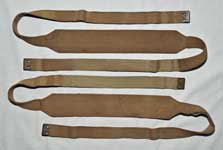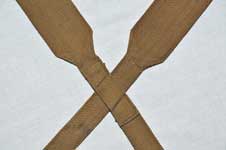| Karkee Web Home Page | Officer's Main Page | W.E.O. Main Page | W.E.O. Experimental Main Page |
Web Equipment, Officers, Experimental
Braces & Straps

 The introduction of “reduction weaving” allowed these Patt. ’13 style Braces to be employed – no re-inventing the wheel here. They were handed pairs, the right Brace having a crossing loop on its inside face, though this was not identified in the Vocabulary. The loop was stitched adjacent to the flare, much higher than the same loop on Patt. ’37 and was additionally stitched on a diagonal, ensuring correct use of the Brace, left, and the Brace, right, with loop. The placement of the loop on the right Brace was later standardised as being “left-with-loop” in other Patterns.
The introduction of “reduction weaving” allowed these Patt. ’13 style Braces to be employed – no re-inventing the wheel here. They were handed pairs, the right Brace having a crossing loop on its inside face, though this was not identified in the Vocabulary. The loop was stitched adjacent to the flare, much higher than the same loop on Patt. ’37 and was additionally stitched on a diagonal, ensuring correct use of the Brace, left, and the Brace, right, with loop. The placement of the loop on the right Brace was later standardised as being “left-with-loop” in other Patterns.
 Inside view of the Braces, showing the diagonally stitched crossover loop on the Brace, right, with loop.
Inside view of the Braces, showing the diagonally stitched crossover loop on the Brace, right, with loop.


![]() The “gateleg” slides, for attachment to the Belt, were an improved form of the fittings used on earlier Brace attachments. In place of the two fixed central prongs, a single long brass wire pin was hinged on the top short edge of the buckle frame. Attachment points, below the belt, were created with a loop on the lower short leg of the gateleg slides. The lower short edge of the slide was recessed for the pin. A short length of doubled webbing led from the gateleg to a circular ring, with a shorter, doubled length above, in which a 4-bar buckle, or Buckle, brass, 1-in., with loop was stitched. The proportions of these webbing pieces exactly placed the ring behind the upper edge of the Compass and Ammunition pockets. The junctions between the perpendical parts of the gateslide buckle, the inside edges of which show evidence of blanking, are so smooth as to otherwise imply they were cast products. It seems that nothing was too good for an Officer and Gentlemen, so extended rumbling must have been employed to achieve this effect. The different weave would have been less durable, so the extra attention to the metal fittings would have made for less wear on the webbing.
The “gateleg” slides, for attachment to the Belt, were an improved form of the fittings used on earlier Brace attachments. In place of the two fixed central prongs, a single long brass wire pin was hinged on the top short edge of the buckle frame. Attachment points, below the belt, were created with a loop on the lower short leg of the gateleg slides. The lower short edge of the slide was recessed for the pin. A short length of doubled webbing led from the gateleg to a circular ring, with a shorter, doubled length above, in which a 4-bar buckle, or Buckle, brass, 1-in., with loop was stitched. The proportions of these webbing pieces exactly placed the ring behind the upper edge of the Compass and Ammunition pockets. The junctions between the perpendical parts of the gateslide buckle, the inside edges of which show evidence of blanking, are so smooth as to otherwise imply they were cast products. It seems that nothing was too good for an Officer and Gentlemen, so extended rumbling must have been employed to achieve this effect. The different weave would have been less durable, so the extra attention to the metal fittings would have made for less wear on the webbing.
Since a Pack was listed, of Patt. ’08 W.E. form, different Brace attachments may have existed. This is discussed under Straps, supporting below.
Straps, supporting
The price quoted in the Vocabulary is 8d – eightpence, or 3.33p in modern decimal coinage. This is exactly the same price as Patt. ’08, Straps, supporting, so it follows that they must be identical. In turn, the Pack must therefore have been of Patt. ’08 form, rather than the Rucksack in the Hazell advertisements. However, this presents a problem: 2-in. sliding buckles could be placed on the Brace flares, to accommodate the 2-inch tabs on the Pack. There is then no diagonal strap to attach the buckle ends of the Supporting strap. It suggests that these straps were instead employed as “shoulder straps”, to carry the Pack in rucksack fashion.
The coupling of W.E.O. to W.E., Experimental, Officers, rather stands, or falls on this point. If the attachment of the Pack was the same as in Patt. ’08 W.E., the Brace attachments would need “diagonal straps”, akin to those of Patt. ’08 Attachments, or an angled derivative of the Cavalry Trials type. This would mean there were two designs of officers’ webbing…!
© R.J. Dennis February 2009